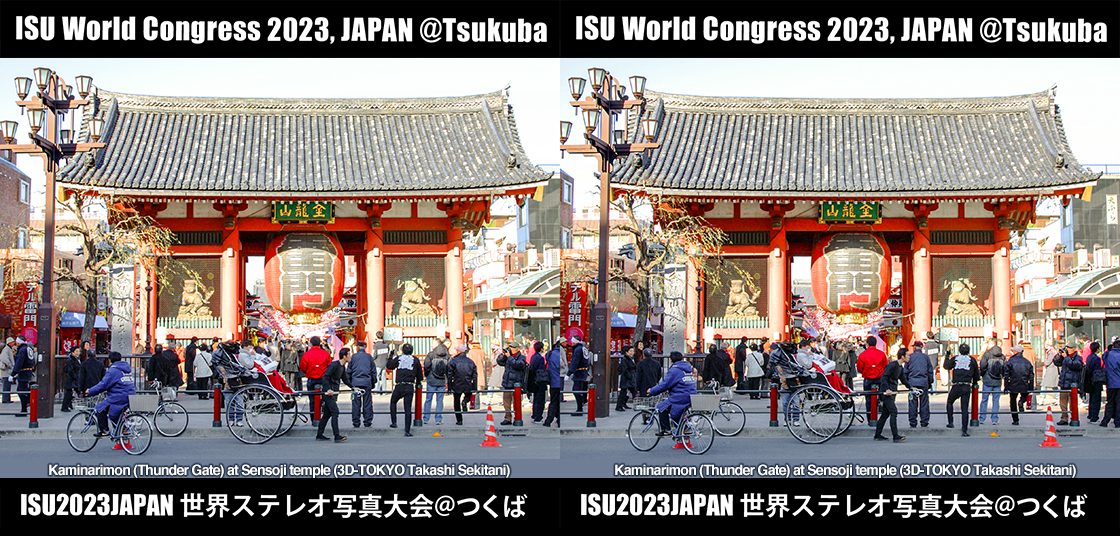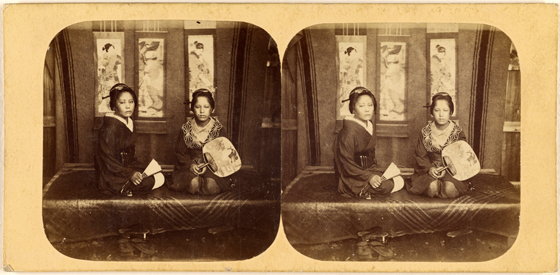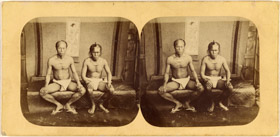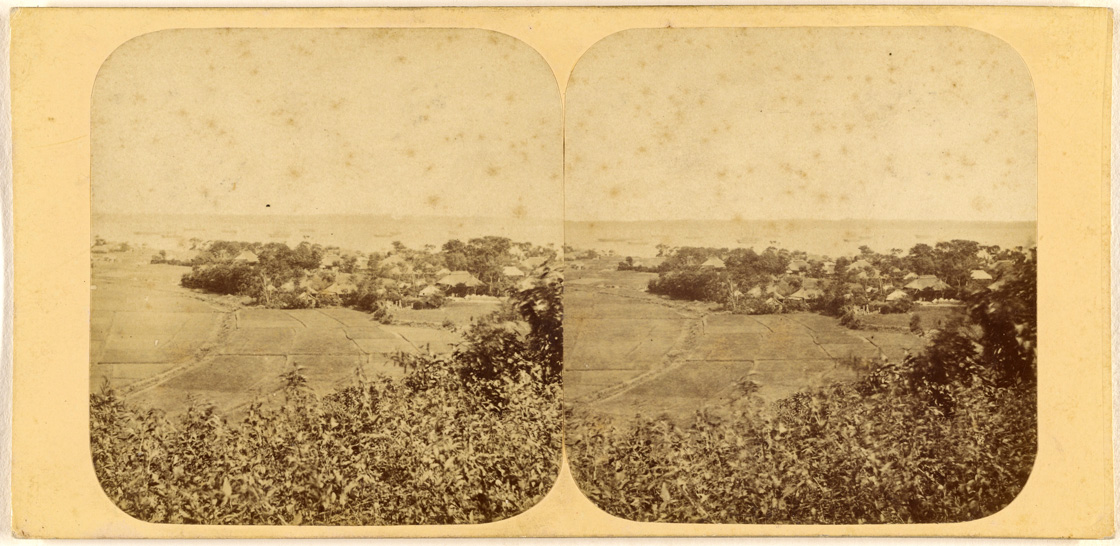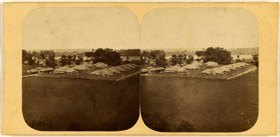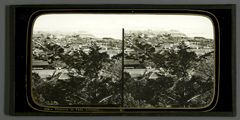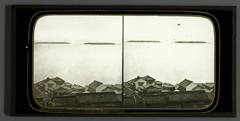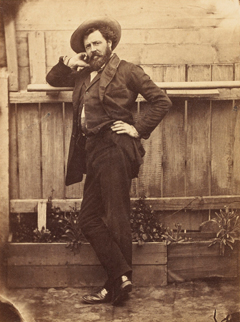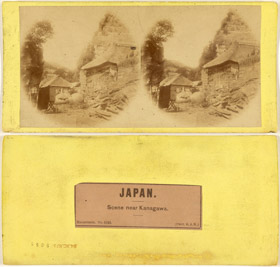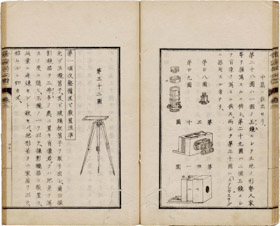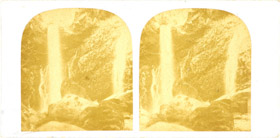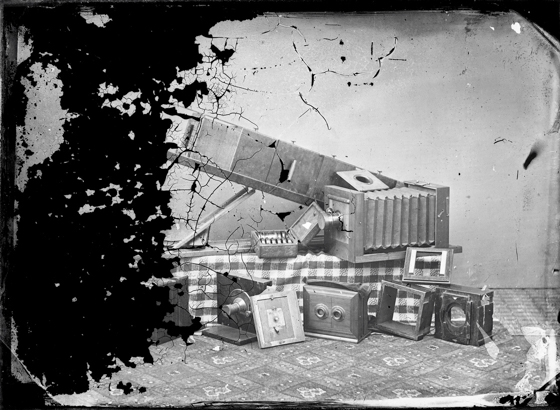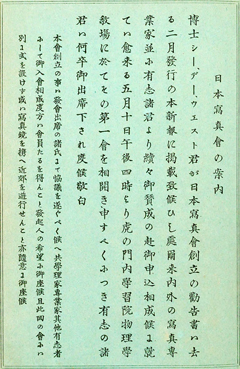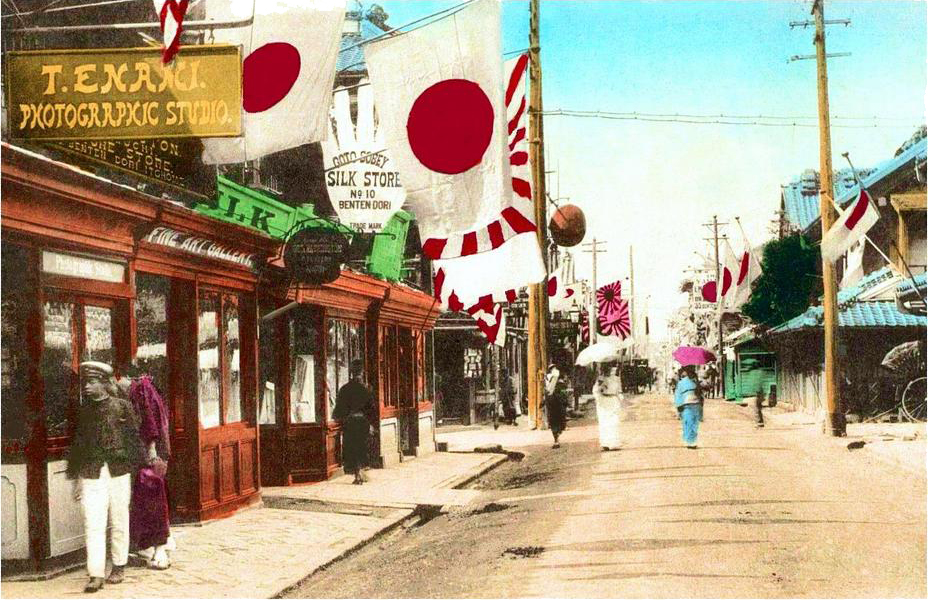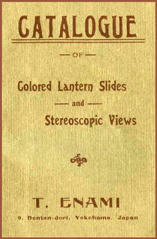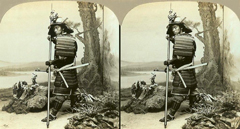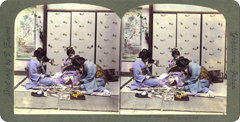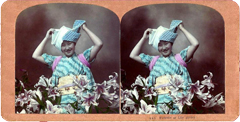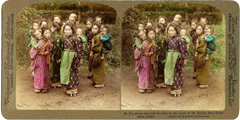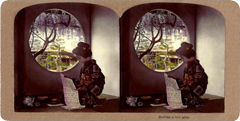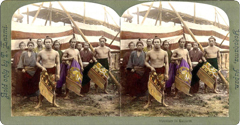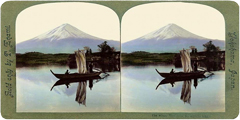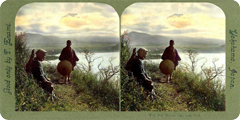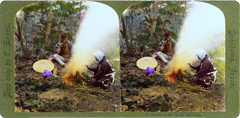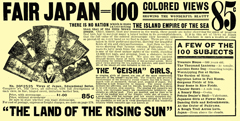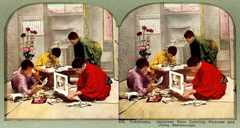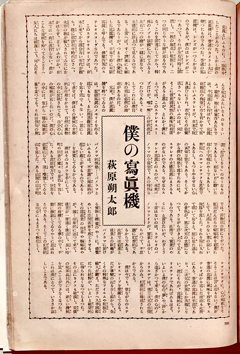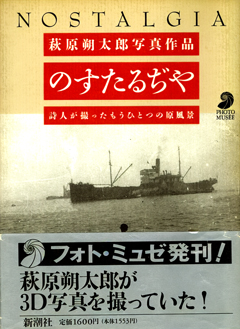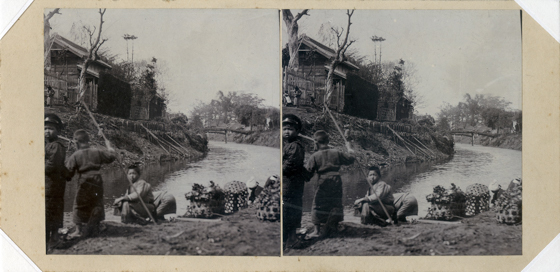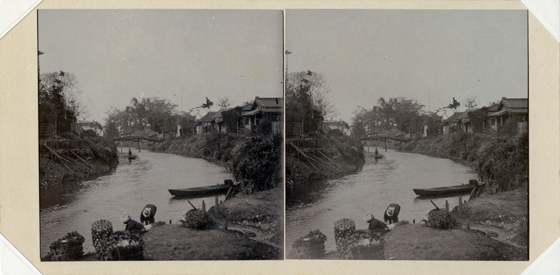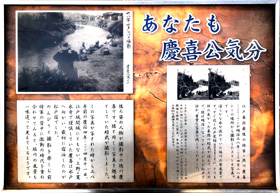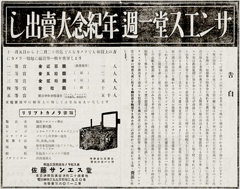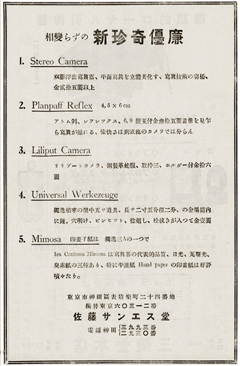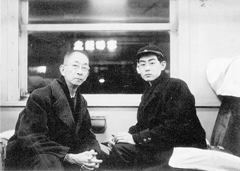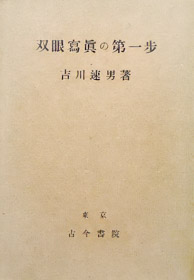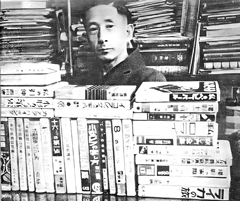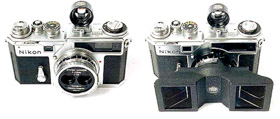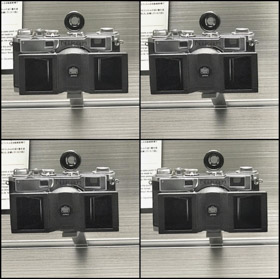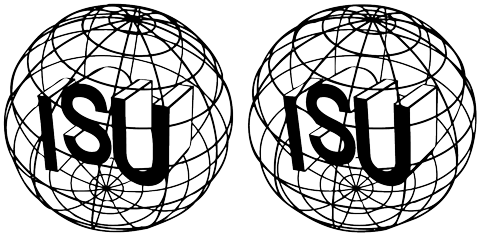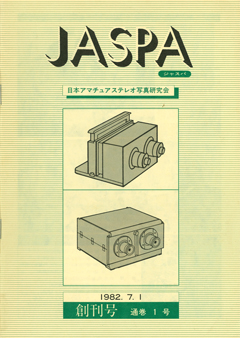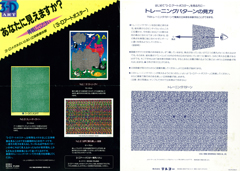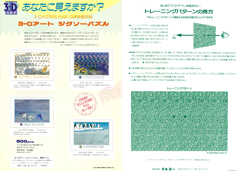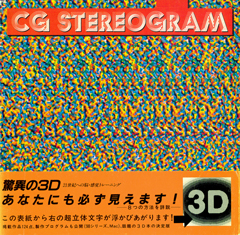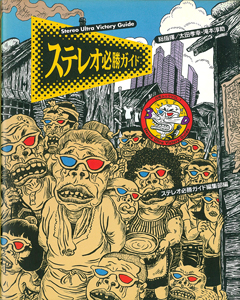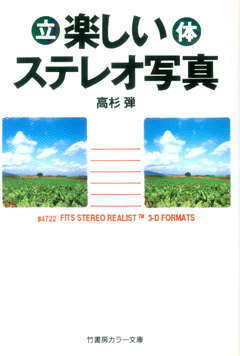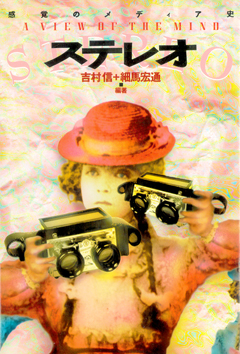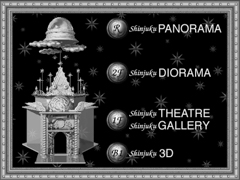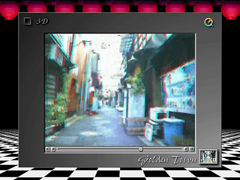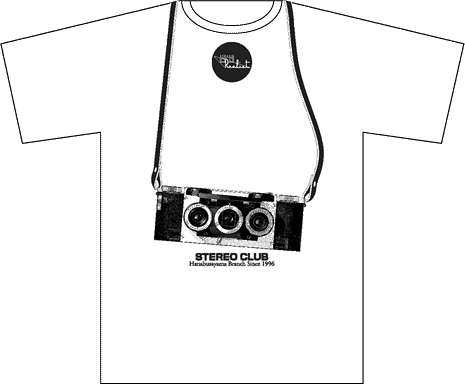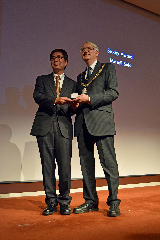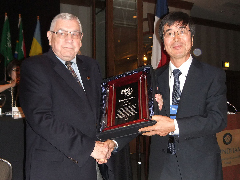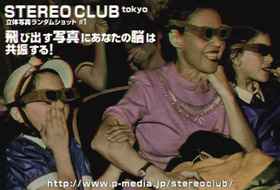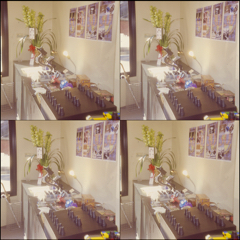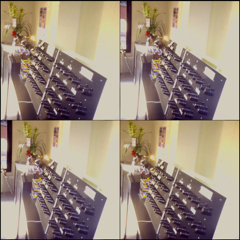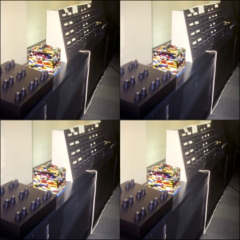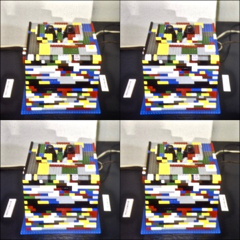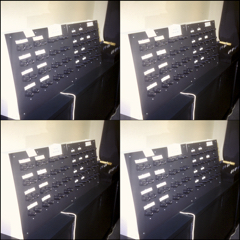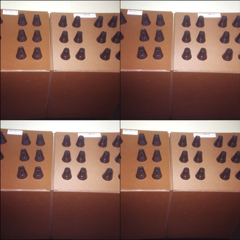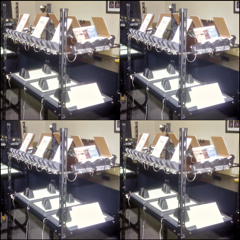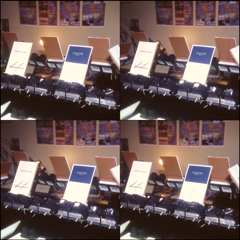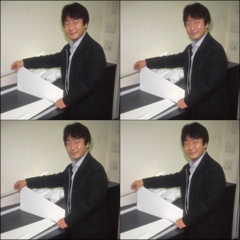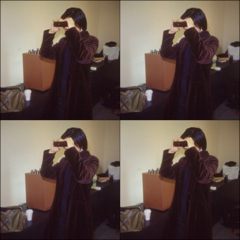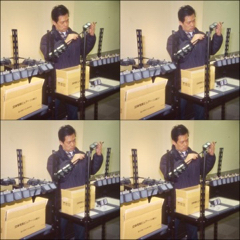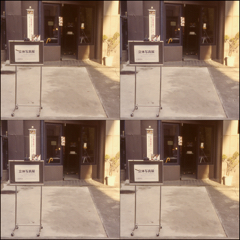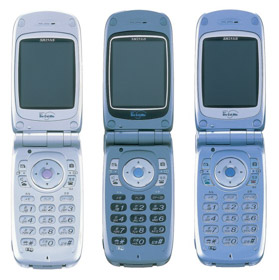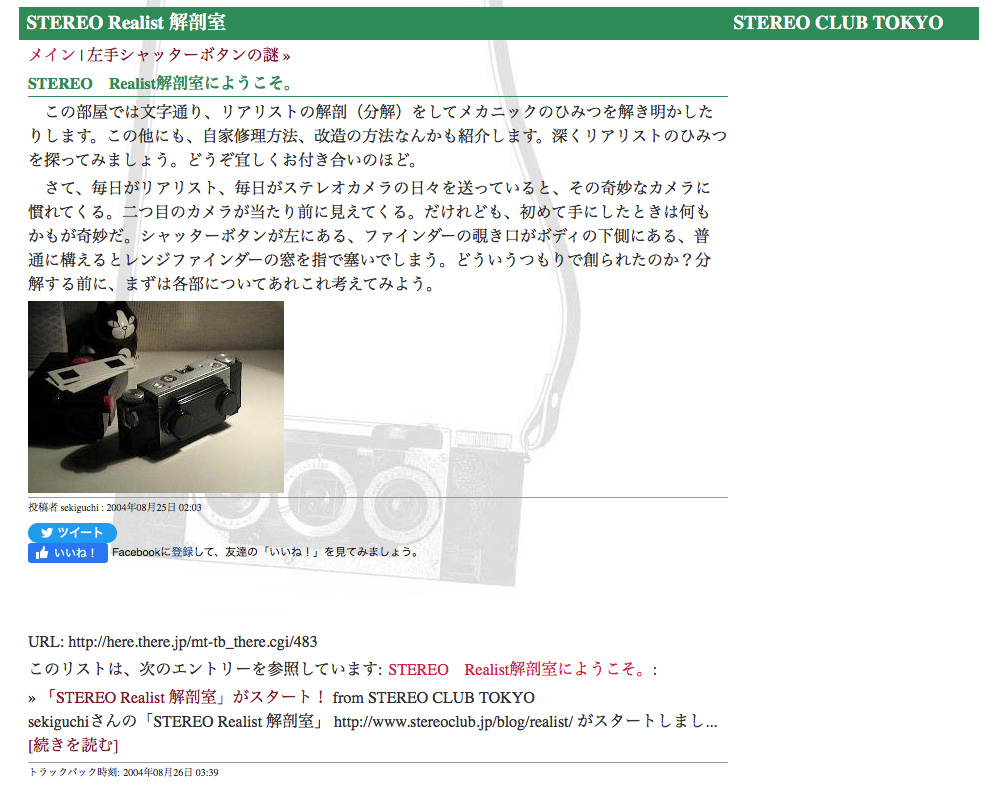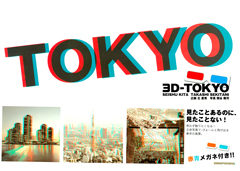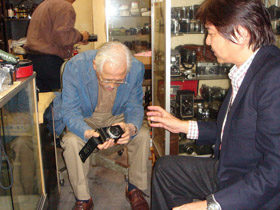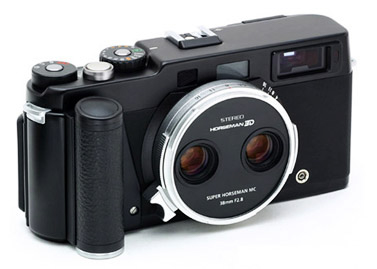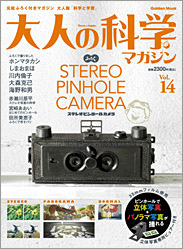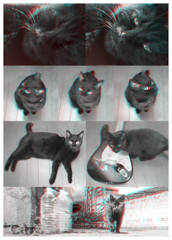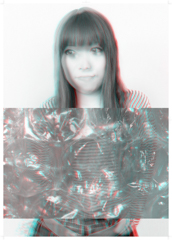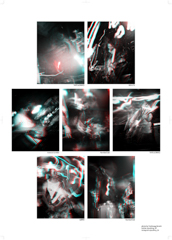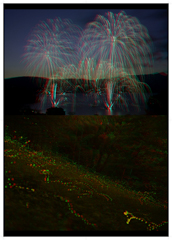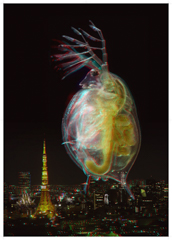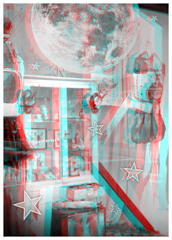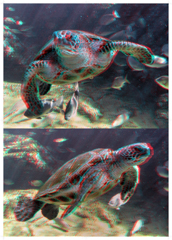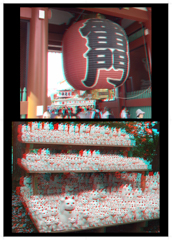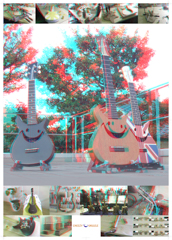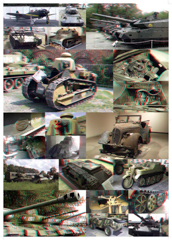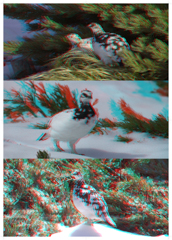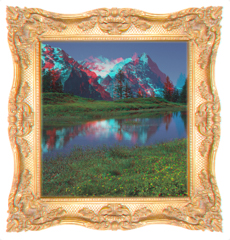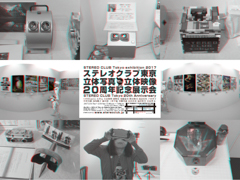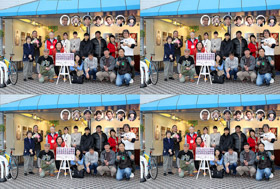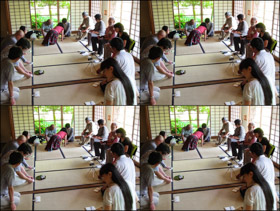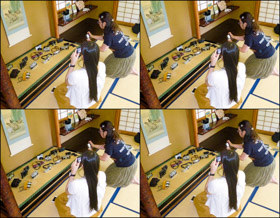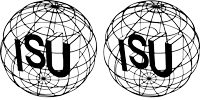 Japan
Japan STEREO CLUB Tokyo
STEREO CLUB Tokyo ISU
ISU
- 1825 The oldest surviving photograph of a 'horse-drawn man' taken by 『Un cheval et son conducteur』
- 1833 Wheatstone makes a Mirrored 3D viewing device. He then named it the stereoscope. The birth of STEREO
- 1839 Daguerreotype
- 1849 Brewster stereoscopes and stereo cameras
- 1851 Brewster's Stereoscope was exhibited at the London Expo. Queen Victoria was enthused, and the public also responded with great enthusiasm, leading to a subsequent stereo boom.
- 1851 Collodion process
- 1853 Wilhelm Rollmann invented the anaglyph
- 1854 For the first time ever, a photograph was taken in Japan by American photographer Eliphalet Brown Jr
- 1854 The London Stereoscopic Company
1859 安政6
At the end of the Edo period (1859-60), Swiss stereo photographer Pierre Rossier came to Nagasaki. He came to Japan on behalf of Negretti and Zambra, a London-based optical equipment company that also published stereo cards, to take photographs and conduct business.
During his stay, he taught wet photography to first generation Japanese photographers such as Ueno Hikoma in Nagasaki, and took stereographs and panoramic photographs in Yokohama and elsewhere. The stereographs were published in the View of Japan series by Negretti and Zambra from April 1860.
- [Photo] Japanese Ladies, in Full Dress. - Winter Costume.1858–1859
- [Photo] Japanese Workmen, in Summer Costume.1858–1859
- Photography in Japan 1853-1912 | Terry Bennett | Amazon
- Geneses of Photography in Japan: Nagasaki
- Pierre Rossier - Wikipedia
- Pierre Joseph Rossier Collection (Getty Museum)
- [JP]Recorded "International Symposium on Early Photography 'Bakumatsu'" - The Tokyo Photographic Art Museum
The earliest photograph of Yokohama was a stereograph by Pierre Rossier.
- [Photo1] Yakuama. View of the New City of Yakuama, with European Shipping in the Bay
- [Photo2] Yakuama. General View of Yakuama.
- Yakuama(Yokohama) : Pierre Joseph Rossier Collection (Getty Museum)
- [JP]館報「開港のひろば」 横浜開港資料館(Museum bulletin "Kaiko-no-hiroba", Yokohama Port Opening Museum)
- [JP][座談会]古写真でみる 文明開化期の横浜・東京
(Roundtable discussion : Yokohama and Tokyo during the period of civilisation and opening to the outside world in old photographs)
- 1861 Holmes-Bates stereoscope
1861 文久1
French photographers Antoine Fauchery and Colonel Charles-Louis Du Pin came to Yokohama in January.
Antoine Fauchery (1823-1861) was a painter, architect, woodworker and journalist in Paris before moving to Melbourne, Australia, to become a adventurer in search of success in gold mining. Unsuccessful as a adventurer, he returned to Australia to learn photography from his friend, the famous photographer Nadar, and in 1857 he went back to Melbourne, Australia, where he opened a photography studio and published his first book, Sun Pictures of Victoria, in 1858. In February 1859 he left Melbourne via Manila in the Philippines, arriving in Shanghai, China, in June 1860 to cover the Opium War as an official correspondent for the French Army. From Shanghai, he arrived in Yokohama, Japan, in January 1861 with Colonel Dupin, his commanding officer in China. He died three months later, on 27 April 1861, in Yokohama. (The cause of his death is unknown.) Stereo photographs taken during those three months were subsequently published by Ferrier & Soulier in France.
*Du Pin, a colonel attached to the French General Staff, came to Nagasaki in January 1861, then moved to Yokohama; in March he lived in Edo to be available to Bellecour, the French Minister to Japan. Fochery came to Japan with him, assisting Du Pin in taking photographs in Shanghai before his arrival. The two worked as a team on the shoot." (From Christian Polak, Lilies and Giant Cannons.)
*It is only speculation, but it is said that the model for Utagawa Yoshitora's French Housewife and Her Husband, painted in 1961, may be Antoine Fochery in Japan. This is due to the fact that Antoine Fochery was the only confirmed French photographer staying with his wife in Yokohama at the time, and that he took stereo photographs in Japan. The port of Yokohama opened in 1859 and a foreign settlement was established in 1860. This painting depicts the lives of the foreigners living there and became very popular and is known as the "Yokohama-e" ukiyoe.
*Antoine Fauchery belonged to the Bohemian circle when he was active in Paris, and was in contact with a number of prominent artists, and is famous as the model for the painter in the original opera La Bohème.
- [img1]Gezicht op Tokyo, Japan, Antoine Julien Nicolas Fauchery (attributed to), Ferrier Père-Fils et Soulier (attributed to), 1861 - Rijksmuseum
- [img2]Gezicht op zee vanuit Tokyo, Antoine Julien Nicolas Fauchery (attributed to), Ferrier Père-Fils et Soulier (attributed to), 1861 - Rijksmuseum
- [img3] 外国人遊行之図 仏蘭女人
- Antoine Fauchery, 1823–1861: photographer and journalist par excellence - No 33 April 1984 - La Trobe Journal
- Antoine Fauchery – Wikipedia
- Cimetiere a Yedo. & Sous Gouverveur. by Antoine Fauchery & Charles Du Pin.: (1861) Photograph | The Isseido Booksellers, ABAJ, ILAB
- Nadar - Wikipedia
- Charles-Louis Du Pin — Wikipédia
- Utagawa Yoshitora | French Housewife and Her Husband | Japan | Edo period (1615–1868) | The Metropolitan Museum of Art
- Utagawa Yoshitora - Wikipedia
- Yokohama-e - Wikipedia
Shimooka Renjo and the Mystery G.A.B StereoviewSeries by Terry Bennett & Rob Oechsle
Mystery: "Renjo Shimooka may have been the first person in Japan to take stereographs."
- []Photo] Japan. Scene near Kanagawa. George A. Baader [G.A.B.5525]
- Shimooka Renjo and the Mystery G.A.B StereoviewSeries by Terry Bennett & Rob Oechsle - Stereo World Magazine Volume 39, Number 4 • January/February 2014
- Tom Burnett Collection
- Collection: T. ENAMI 江南 信國 JAPAN | Okinawa Soba (Rob Oechsle) | Flickr
- George A. Baader [G.A.B.] (Getty Museum)
1862 文久2
Ueno Hikoma published a chemistry book, "Chemistry Bureau Essentials".
Volume 3: Appendix "Photographic Techniques" was a manual for wet-plate photography and included a stereo camera. This was the first time a stereo camera was published in a book in Japan.
- [Book] Chemistry Bureau Essentials Volume 3: Appendix Photographic Techniques
- Ueno Hikoma - Wikipedia
- [JP]NATIONAL ARCHIVES OF JAPAN Digital Archive - 舎密局必携3 (Chemistry Bureau Essentials, Vol. 3, Supplement, 'Photography Techniques)
- [JP]NATIONAL ARCHIVES OF JAPAN - Twitter
- 1868 Meiji Restoration
1869 明治2
In 1869, the oldest surviving stereo photograph taken by a Japanese was taken in Nikko by Yokoyama Matsusaburo.
"Yokoyama Matsusaburo took photographs of all the mountains of Nikko with his pupils and ten labourers, and introduced the waterfalls and other scenic spots in the mountains through photographs. It also took stereo-photographs of waterfalls and scenic spots in all the mountains of Nikko.
These photographs of Nikko were taken by Yokoyama Shozaburo and Shimooka Renjo and are said to have been presented to the Tokugawa family."
(Hajime Chiyo, 'Biography of Yokoyama Matsusaburo, a forerunner in Western painting and photography, and from the collection of the Hakodate City Museum)
- [Photo1] The oldest surviving stereo-photograph taken by a Japanese. Yokoyama Matsusaburo, Nikko Ryuzutaki Waterfall 1869 (Hakodate City Museum collection)
- [Photo2] Photo by Yokoyama Matsusaburo Photo equipment taken at his photo studio. A stereo camera is placed in the centre. (Hakodate City Museum collection)
- Yokoyama Matsusaburō - Wikipedia
- Hakodate City Museum
- [JP]市立函館博物館研究紀要第1号(1990)『千代 肇/西洋画・写真術の先覚者横山松三郎伝と函館博物館所蔵品』
(Pioneer of Western painting and photography Biography of Matsusaburo Yokoyama and the Hakodate Museum collection) - Excursions : 18 September (Monday, public holiday) Nikko Toshogu Shrine and Trick Art Museum
1889 明治22
Inauguration of Japan Photographic Association, the first photography club in Japan.
W.K. Barton (1856-1899), who had achieved great success in his native England with his research on dry plates, came to Japan from England in 1887 to become a professor (sanitary engineering) at the University of Technology (now the University of Tokyo Faculty of Engineering). With the advent of dry plates, it became possible to take and develop photographs much more easily than with the wet plates that had been used until then, and an era of amateur photography enthusiasts had arrived in this advanced photographic country. The arrival of Mr Balton (as he was nicknamed in Japan) was a great opportunity to bring such an era to Japan in the Far East. He was indeed a dry plate conductor for the Japanese photographic world. At the initiative of Ogawa Kazuma, a photographer who had been paying attention to Mr Balton, the Japan Photographic Association was founded with the three men as its patrons, with Kashima Seibei, a photography magnate, playing a central role. At the time of its founding, the society was chaired by Takeaki Enomoto and consisted of 56 people, including political and financial figures, academics, foreign residents in Japan and other photography enthusiasts, as well as people involved in the industry. Balton exhibited several binocular pictures (stereographs) at the annual meeting of the Japan Pictures Society held at Hongo, Tokyo University on 22 May 1896. (Shashin Getsuppo June 1896) Unfortunately, however, these stereographs were said to have been burnt or lost, and no stereographs of Mr Balton have survived.
- [img][JP]『日本寫眞會の案内』寫真新報 3号(1889年4月)に掲載された。「5月10日午後4時より虎ノ門内学習院物理学教場に於てその第1會を相開き申すべく…」
- [JP]写真月報 3(26) - 国立国会図書館デジタルコレクション
1892 明治25
T.Enami's Enami photo studio opened at 1-9 Benten-dori, Yokohama.
Enami Nobukuni photographed stereo cards for many foreign tourists under the T.Enami brand. A beautiful hand-coloured stereo card with the inscription "Yokohama Japan, Sold only by T.Enami" is included in the photographic catalogue "CATALOG OF COLOURED LANTERN-SLIDES AND STEREOSCOPIC VIEWS", published in 1908. T.ENAMI", a photographic catalogue published in 1908, lists some 1100 stereo photographs. Many stereo cards were also sold in the USA by several companies, including SEARS, ROEBUCK & CO.
"Enami was caught between at least two worlds. For instance, there was, on the one hand, the market that wanted him to vanish and provide a transparent view of Japan and, on the other, his own artistry and craft that sought beauty and affect. "(Jonathan E. Abel"The New Real - Media and Mimesis in Japan from Stereographs to Emoji")
- [img] T. ENAMI'S PHOTOGRAPHIC STUDIO - A Quiet Day on Benten Street, Yokohama, ca.1900-05
- Collection: T. ENAMI 江南 信國 JAPAN | Okinawa Soba (Rob Oechsle) | Flickr (The stereo photo of T. ENAMI Enami Nobukuni shown here was borrowed from this website).
- Jonathan E. Abel『The New Real "Media and Mimesis in Japan from Stereographs to Emoji"』
- 1871 Dry plate photography
- 1883 Ezaki Reiji took the first dry plate photographs in Japan
- 1889 Roll film for photography introduced by Kodak
- 1895 Lumière brothers show films
1903 明治36
Hagiwara Sakutaro, one of Japan's most celebrated poets, began taking stereographs at the age of 17.
"Anyway, for me, this stereoscope was the one and only good companion. And there is an inevitable reason for this for myself." (From Hagiwara Sakutaro's "My Camera")
"My father became interested in photography when he was a junior high school student in 1902, and he bought a photographic machine for 65 sen at the time, but when he went to his father's family home in Osaka in May the following year, he was already using a Stereo Camera, taking pictures of landscapes."
"From his junior high school days until his later years, he looked through stereo photographs (he also looked through ready-made foreign-made photographs), and even before his death, when he was lying on his sickbed, he kept it by his bedside." (From Hagiwara, Yoko, 'My Father and Stereographic Photography', Nostalgia)
- [Photo] Stereograph taken by Hagiwara Sakutaro (Collection of Maebashi City Museum of Literature).
This stereograph was taken on the Hinkaku railway line in Magome (now part of Ota Ward) during its construction. From left to right: Yoko (eldest daughter), Akiko (second daughter). Hagiwara Sakutaro lived in Magome from 1926 to July 1929, during which time this photograph was taken. - [Book] My Camera (Asahi Camera, October 1939).(TEXT PDF)
- [Book JP] 萩原朔太郎写真作品 のすたるぢや―詩人が撮ったもうひとつの原風景 (フォト・ミュゼ) | Amazon
- [JP]Hagiwara Sakutaro Memorial, Maebashi Literature Museum, City of Water, Greenery and Poetry
- Hagiwara Sakutarō - Wikipedia
- Hagiwara Yōko - Wikipedia
- Photographs by Hagiwara Sakutaro NOSTALGIA Another original landscape photographed by a poet | Amazon
- [JP]My Camera(僕の寫眞機)(1939) PDF
- [JP]萩原朔太郎にとっての立体写真と「永遠の『錯誤』」 – comics and songs かにのあぶく /細馬宏通
- [JP]萩原朔太郎とステレオ写真 - MIDIステレオ館
- [JP]萩原朔太郎 ステレオカメラ、詩人の切りとる大正・昭和の風景写真 - 逸話のうつわ
- Around this time, stereo photography enthusiasts were born in Japan.
- 1904 Jacques Henri Lartigue begins taking stereo photographs.
- 1904 Russo-Japanese War
1905 明治38
The last shogun, Tokugawa Yoshinobu, took stereo photographs in Matsudo, Chiba, Japan.
- [Photo1,2] Stereo photograph (1905) taken by Tokugawa Yoshinobu at the Saka River near the Tojo residence in Matsudo, Chiba Prefecture, Japan. (Collection of the Tojo Museum of History, Matsudo, Japan/Provided)
- [Photo3] You too can feel like Shogun Yoshinobu Tokugawa (Japan's only stereo historical site)
- [Photo4] Current state of the filming location (March 2021)
- Tojo Museum of History
- Tokugawa Yoshinobu - Wikipedia
- [JP](没後100年 徳川慶喜展)|SHIZUOKA CITY MUSEUM of ART (100 years after his death: Tokugawa Yoshinobu Exhibition)
- 1915 3d film was tested at the Astor Theatre in New York (Anaglyph)
- In Japan until this period, stereo-photography was known as binocular photography, real photography, pop-up photography, three-dimensional photography, etc.
1921 大正10
Sato San-Esu Do (佐藤サンエス堂) opens
At the time, the only shop in Japan specialising in stereo equipment (import/sales). Located at 24 Sarugakucho, Kanda-Ku, Tokyo, now Kanda Jimbocho 1-chome.
"A year may seem like a long time, but in hindsight it is surprisingly short. It seems like it was only a few months ago that San-Esu-do opened for business, but on 15 November it will be exactly one full year!" from an advertisement in the November 1922 issue of 寫眞藝術.
"Around the beginning of the Taisho era (1912-1926), Sato Shusuke listened to my opinion and opened a shop in Kanda Jimbocho called Sato San-Esu-do, which was actively importing and selling stereo cameras and all equipment. There was probably no other shop specialising in stereo in Japan before or after this one. This was the result of Mr Sato's own enthusiasm for stereo. "from "Me and Stereo" (Yoshikawa Hayao, Fifty Years with the Camera, 1947, Kōgassō)
- [Image1] Advertisement in the November 1922 issue of 寫眞藝術
- [Image2] Advertisements in the February 1923 issues of 寫眞藝術
- [Image3] Advertisements in the September 1923 issues of 寫眞藝術
- 1923 Great Kantō earthquake
1923 大正12
Japan Binocular Photo Club (日本双眼寫眞會) founded.
The first stereo club in Japan, founded by Yoshikawa Hayao, the first stereo photo evangelist in Japan, and Syusuke Sato, the first stereo specialist shop owner in Japan.
"The Japan Binocular Photo Club was established under the leadership of Yoshikawa Hayao and Sato Shusuke. This is something that people who have read the articles on binocular film in this magazine have been eagerly awaiting. If you need a copy of the rules, please apply to Sato San-Esu-do, 24, Sarugaku-cho, Kanda-gu, Tokyo, enclosing a 2 sen postage stamp. This is probably the most interesting club in recent times." From 寫眞藝術 (寫眞藝術社), April 1923, 寫眞通信.
"It should also be noted that the author has established the Stereo Photography Club of Japan with the aim of researching and popularising this art of photography.
In other words, in addition to researching the art of photography, the club will organise exhibitions and competitions, and select materials and prepare them on an unspecified basis for the benefit of photography researchers." from Yoshikawa Hayao, New Studies in the Art of Photography, 1923
Yoshikawa Hayao (1890-1959) began writing about photography in 1921, and by the time of his death in 1959, he had written more than 200 books.
In his autobiography, "50 Years with the Camera", he wrote that "stereo is at the heart of my photography".
He was also a central figure in a family of stereo enthusiasts that lasted for four generations: his father Yoshikawa Kanekichi, eldest son Yoshikawa Nobuaki and grandson Shima Kazuya.
His grandson Shima Kazuya was the author of the famous book "Introduction to Stereo Photography" in 1979 and was the chairman of the J.A.S.P.A. Japanese Amateur Stereo Photography Association, which was founded in 1982.
"(My grandfather) is called Yoshikawa Hayao. He wrote probably two hundred or more instructional books on photography, not just stereo photography, which can still be found in second-hand bookshops around Kanda from time to time. He was born in 1890, so he must have started around the Taisho era. I think it was after I left university. My grandfather took not only stereo cameras, but also films, mainly what we call small films, like 8 mm, 9.5 mm patee and 16 mm. So he wrote instructional books on regular photography, small films and stereo photography. All of these books were for amateurs and beginners. In my grandfather's time, photography itself was something you had to be prepared to do. To do photography, you had to do the enlarging and so on yourself, so you couldn't do it single-handedly like you can now." [Interview with Shima Kazuya, Genealogy of Japanese Stereo Photography (STEREO: A Media History of the Senses 1994)
- [Phopto1]Yoshikawa Hayao and Yoshikawa Kanekichi (father). In March 1909, when Hayao graduated from high school, father and son went on a photography trip around Kansai, Kyushu and Tohoku. This photograph was taken at Maiko Beach (Hyogo Prefecture). from Yoshikawa Hayao, The Camera and Fifty Years, Kōgassō 1947.
- [Phopto2]Yoshikawa Hayao and Shima Kazuya (grandson). Taken with a self-timer at Hodogaya Station on the Yokosuka Line when Hayao was a high school student in Kazuya's later years.
- [JP]New Studies in the Art of Photography - Next Digital Library
1930 昭和5
An introduction to stereo photography, 'First Steps in Stereo Photography', by Yoshikawa Hayao, published.
- [Book] First Steps in Stereo Photography
- [Photo] Self-published book photographed with a Leica. First Steps in Stereo Photography can be seen in the lower left-hand corner. Photo of me and my book taken about five years ago (1942) I had decided to preserve a part of my book as it was published, but some of it was lost, and this is the remainder. These are pictures like those of a second-hand bookshop keeper, but none of them remain now because of the war, and they have become one of my memories." from Yoshikawa Hayao, The Camera and Fifty Years, Kōgassō 1947.
- [JP]双眼写真の第一歩 (古今書院): 1930|National Diet Library
- 1934 Leica launches Stereoly
1936 昭和11
Audioscopiks, the first 3D film to be screened in cinemas in Japan, was released.
1938 昭和13
TAKARAZUKA REVUE's Star Troupe performed a shadowgraph show performance. Audience members wearing anaglyph glasses enjoyed seeing the red and blue anaglyph shadows of the dancers in three dimensions.
- {JP}The Takarazuka Revue and its era in the early Showa period (18) Image from November 1938.
- TAKARAZUKA REVUE Official Website
- 1935 Kodachrome
- 1939 Launch of the Verascope F40 (France)
- 1947 Launch of the Stereo Realist (USA)
- 1952-1954 3D films in the USA 'Golden Age' (polarised light)
1947 昭和22
Yoshikawa Hayao was the first to introduce the Stereo Realist to Japan, which was released in the USA in the same year.
"But the stereo of my past is now doomed to be obsolete. I can say with certainty that from now on we will be using the new film format of 24mm x 24mm, which is a square format. In the USA, the Stereo Realist, a new stereo camera of this size, and the Trivision, a low-level camera, have already been introduced. In many ways, the use of cinematographic film in amateur cameras is the most certain thing in the future, so it is only natural that stereo will also be dominated by machines that use cinematographic film." from "Me and Stereo" (Yoshikawa Hayao, Fifty Years with the Camera, 1947, Kōgassō)
In 1950, he writes that there appears to be only one Stereo Realist in Japan.
"Those who looked at American photographic magazines after the war would have seen publicity for two new products: the high-end Stereo Realist camera, which used 35 mm film, and the cheap Haneel Tri-vision Camera, a bold, streamlined, single-bake, streamlined camera with a single bead. The Stereo Realist is said to be owned by a welfare company in Tokyo. The latter was seen second-hand in a gentleman's material shop some time ago." from [JP]Yoshikawa Hayao, "How to make fun stereo photographs that anyone can easily produce with any camera", Kōga Monthly Magazine, August 1950
1953 昭和28
The first domestically produced 3D films were released. Two short films, Pop-out Sunday and I Am Aimed at, were produced by Toho.
1955 昭和30
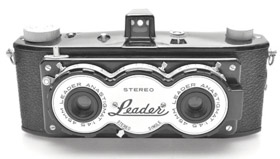
The 35 mm stereo camera Stereo Leader was released by TogoDo.
1957 昭和32
Nikon launched the Stereo NIKKOR 3.5cm f/3.5.
During the stereo boom of the 1950s, many stereo cameras were launched. This Nikon lens was also produced during that period, but as it was a late starter and was released at the end of the boom, it did not sell well and production ended after a short period.
Only about 100-200 of these lenses were produced, and they are now sold at high prices as collectors' items.
- [Photo1] Stereo-NIKKOR 35mm F3.5
- [Photo2] On display at the Nikon Museum in Shinagawa, Tokyo.
- Nikon's Stereo-Nikkor 1:3.5 f=3.5cm special wideangle lens for Nikon S-Mount Rangefinder cameras
- 1964 Asahi Kogaku launches Stereo adapter for Asahi Pentax SP.
- 1974 National Stereoscopic Association (NSA)
1972 昭和47
Okoshi Takanori's book "Three-Dimensional Imaging Techniques" was published by Sangyo Tosyo (産業図書)
1975 昭和50
The International Stereoscopic Union is founded.
- 1977 Sakane, Itsuo, Natural History of Play, Published
- 1977 Reel 3-D Enterprises
1977 昭和52
The 3D animation Nobody's Boy: Remi (51 episodes) was broadcast using the Pulfrich effect.
1979 昭和54
Shima Kazuya's "Introduction to Stereo Photography (ステレオ写真入門)", a must-have classic, is published.
Shima Kazuya is the grandson of Yoshikawa Hayao,
1982 昭和57
J.A.S.P.A. The Japan Amateur Stereo Photographic Association was founded. Okamura Meikichi, representative of TOA PHOTO/Diamond Camera, initiated the idea of starting the association and called together people involved in stereo photography. Among them, Shima Kazuya was selected and became the first president. Shima Kazuya is the grandson of Yoshikawa Hayao, who founded Japan's first stereo club, the Japan Binocular Pictures Club (1923), and is the author of "An Introduction to Stereo Photography" (1979).
The first meeting and launch ceremony was held on Sunday 4 July at 13:30 at the Hibiya Kokusai Building in Tokyo. The October issue of Asahi Camera states that "Membership is now open (more than 120 people have already joined)".
1984 昭和59
Formation of 3D Kansai
"3D Kansai was formed on 22 April 1984 by nine 3D photography enthusiasts living in the Kansai region. When it was first formed, it was called the 'Kansai Stereo Photography Club', but as the number of members increased, their skills improved and they became competent enough to hold an annual exhibition, it was decided to change the name to '3D Kansai'." (from website)
1985 昭和60
Expo 85 was held in Tsukuba, Japan
The Hitachi Group Pavilion, the Sumitomo Pavilion and the Steel Pavilion screened 3D films using the polarisation method. In addition, the Fujitsu Pavilion in the 3D Dome screened 3D films using the anaglyph method. 3D films were screened on large screens at each of the pavilions.
The screening of stereoscopic images was a major topic of discussion and was also known as the Expo of Image Technology, another name for the event.
Tsukuba has since become known as a sacred place for stereo-otaku.
- 3-D At The Fair-EXPO '85's HIGH-PROFILE, HIGH TECH STEREO by Don Marren - Stereo World Magazine : Vol 12 #3 JULY/AUGUST 1985
- Expo 85 (Tsukuba, Japan)
1987 昭和62
Captain EO unveiled at Tokyo Disneyland.
- 1988 ФЭД СТЕРЕО (FED Stereo)
1992 平成4
In May, Tenyo's 3D Art Poster was released and Random Dot Stereograms became a big boom, attracting attention to free viewing (naked-eye stereopsis). In November, C.G. (Computer Graphics) Stereograms - Amazing 3D published by Shogakukan became a bestseller, and many stereo-related books were subsequently published.
- [img1,2]テンヨー『3Dアートポスター』のパンフレット
- [img3][JP]C.G. (Computer Graphics) Stereograms - Amazing 3D | Akasegawa Genpei, Sakane Itsuo | Amazon
- [JP]テンヨーの歩み | TENYO
Hosoma Hiromichi releases Hyoer Card Stack 3D paint.
3D paint ver.5" allows you to enjoy stereo drawing while viewing with the naked eye. Using the Command, Option and Control keys, you can move freely through the depth space. It also has an animation function, so it's quite fun to use." (From HyperCard stack library: Stereo series)
1993 平成5
Ota Takayuki and Takimoto Junsuke, Stereo Essentials Guide Published.
Genpei Akasegawa, Stereo Diary: The Philosophy of Two Eyes, published.
Takasugi Dan Fun stereo photos Published.
"June: finished the manuscript for the Takeshobo collection 'Fun Stereo Photography' in four days. From Takasugi Dan's Chronological Record
Six members - Akasegawa Genpei, Ota Takayuki, Takasugi Dan, Tokuyama Masaki, Miami Shinbo, Yamamoto Chieko and members of the Brain Resort Development Project( Founded in 1992)/Stereo Otaku Society( Founded in 1991) - attended the '9th ISU 1993 World Congress' in Eastbourne, UK, for the entire day.
- [Book] First issue of the magazine Brain World, separate volume [Report on participation in the Stereo World Congress]
1994 平成6
Yoshimura Makoto + Hosoma Hiromichi STEREO: A Media History of the Senses (ステレオ-感覚のメディア史) published.
Asakura, Hideyuki Fish Eyes - Stereographic Photography of a Maldivian Underwater Walk published.
1995 平成7
A multimedia CD-ROM entitled Perspective Technique: Aramata Hiroshi's Bizarre Perspective by CD-ROM(遠近術), produced by the team P-Media, consisting of Mimura Chie,Gozawa Akihide and Okano Izumi, has been published.
QuickTime VR compatible. Contains a stereogram creation function and 3D images.
1996 平成8
STEREO CLUB Tokyo launched.
"The first meeting ended successfully late at night on the 20th.
The meeting started with an introduction to the Ninth World Stereo Convention by Ota Takayuki, followed by a screening of a number of Ota's own works using stereo techniques. All club members were very impressed with the professionalism of the event.
This was followed by a screening of club members' works.
The six members whose works were screened this time were Ryoji Kimura, Susumu Sato, Kazutoshi Otani, Reiko Eto, Izumi Okano and Chie Mimura.Kimura Ryouji has only been using a stereo camera for a week and has already modified the strobe to take pictures inside his house just in time for the screening (applause).
Sato Susumu took snapshots of the shooting site (Sato-san is a photographer) and his workplace. The black mount he made himself is quite cool.
Otani Kazutoshi showed a wide range of works, including Moulton bicycles, French Blue Meeting's maniacal French-made cars, as well as works in the style of street observations in Tokyo.
Eto Reiko's work is centred on the scenery around her home (Tsukuda Island), interspersed with travel photos of various parts of Japan.
Okano Izumi's travel photographs include the Tennozu area where she moved this year, as well as Yamanashi, Yagatake, Nishiyama Onsen, Toba Aquarium and other places.
Mimura Chie began with mimosas (flowers) in Cannes, and then moved on to a personal diary of the past year.
The number of people screening Stereo was a little smaller than planned, but even so, I think it was a screening with a lot of variety. The first meeting ended in a heart-warming atmosphere, with applause after each screening. The most popular film this time was by Reiko Eto.
[Participants this time]
Eto Reiko, Ota Takayuki, Otani Kazutoshi, Okano Izumi, Kimura Ryouji, Gozawa Akihide, Sato Susumu, Sakurai Toru, Serikawa Hiroshi, Tateno Koichi, Mimura Chie, Yoshimura Makoto, the above 11 persons.
From the Secretariat." from 1st STEREO CLUB Tokyo Regular meeting <Winter>
- [Photo] 1st STEREO CLUB Tokyo Regular meeting <Winter>
- [JP]1st STEREO CLUB Tokyo Regular meeting <Winter>
1999 平成11
STEREO CLUB Tokyo Meeting <Special> [Meeting with Alexander Klein] 22 May 1999 (Fri)
Alexander Klein came to STEREO CLUB Tokyo, the first meeting The first meeting between the ISU and STEREO CLUB Tokyo.
- [Photo] Alexander Klein came to the STEREO CLUB Tokyo
- 2000 Paris in 3D From Stereoscopy to Virtual Reality 1850-2000 exhibition at the Carnavalet Museum, Paris.
2000 平成12
Yuda Akio's website, Stereo Photography of Dekoyama (Convex Mountains) -- Refresh Your Brain, has been launched.
As of January 2023, the website contains a huge number of stereo photographs of wildflowers, alpine plants and landscapes, mainly in the Shinshu region of about 16,000 pairs.
Other "Books on Stereo Photography", "Stereo Cameras and Viewers", etc.
2002 平成14
The first year of digital STEREO
Suto Masuji releases Stereo Photo Maker.
It is a Windows App for almost all digital processing related to stereo photography. After Stereo Photo Maker, Suto Masuji has been actively developing other Win Apps, as well as numerous stereo Apps for iOS and Android smartphones/tablets. His achievements in developing a number of must-have Apps for stereo enthusiasts have been recognised worldwide, winning the Royal Photographic Society Saxby Award in 2015 and the Photographic Society of America Progress Award in 2016.
- Muttyan's Home Page (English) : StereoPhoto Maker
- Royal Photographic Society : Awards and medals - Wikipedia
- Photographic Society of America : progress-awards
STEREO CLUB Tokyo organises Stereo Photo Random Shot #1: Your Brain Resonates with the Popping Photo! Exhibition
World's first 3D mobile phone, SH251iS, launched.
Equipped with 3D LCD and 2D-3D conversion function.
STEREO CLUB Tokyo provided 3D demonstration images.
Pentax Optio 230
World's first digital camera with stereo photo creation function.
2004 平成16
Sekiguchi Junichii's Blog STEREO Realist Anatomy Room (STEREO Realist 解剖室) is launched.
- 2005 The London Stereoscopic Company, which was dissolved in 1922, was re-established by Brian May
- Terry Bennett Photography in Japan 1853-1912
2006 平成18
Publication of 3D-TOKYO, a collection of stereo photographs by Sekitani Takashi.
Horseman 3D, almost the last film photography Western stereo camera, was released by Horseman. Product produced by Yamaguchi Jin of the Horseman company.
- [Photo1] Yamaguchi Jin (foreground) and Mr Naoi of Naoi Camera Service.
- [Photo2] Horseman 3D
Japan's top idol group SMAP performed nationwide with their Pop Up! SMAP LIVE! Tour, which incorporated 3D images into the show.
Otona no Kagaku Vol 14 Stereo Pinhole Camera (Gakken) published.
- [Photo] Group photograph of the 31st STEREOCLUBTokyo meeting taken with a stereo pinhole camera
- [JP]Vol.14 ステレオピンホールカメラ | 大人の科学マガジン | 大人の科学.net
2008 平成20
Maeda Satoshi's Stereo Photography Collection Stereo Photography Works: 3D ∞ Infinity (ステレオ写真作品集 立体∞無限) published.
A collection of stereo photographs taken with a Hasselblad in scenic areas around the world.
- 2009 Avatar film released.
2009 平成21
FinePix REAL 3D W1 launched by Fujifilm.
2011 平成23
Launch of the Nintendo 3DS.
Portable games console with stereo camera and glasses-free display; 75.87 million units shipped worldwide by the end of sales in 2020. Most popular 3D device in history.
Suto Masuji releases 3DSteroid (Android) and i3DSteroid (iOS).
Stereo life on smartphones begins.
2012 平成24
New logo for STEREO CLUB Tokyo created by Sachi Empty Ika of STEREO MONSTERS unveiled.
The 3D Century: Wonders! 100 Years of Stereoscopic Imaging and the New Century of Imaging by Ooguchi Takayuki, et al. is published, a major work unparalleled in the world that covers the entire spectrum of 3D cinema.
2013 平成25

STEREO CLUB Tokyo won the International 3D Society Good Practice Award 2013 - Incentive Award .
2017 平成29
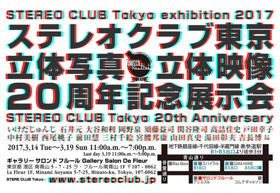
Exhibition STEREO CLUB Tokyo: 20th Anniversary Exhibition of 3D Photography and 3D Imaging
- [Photo] Group photo of participating members
StereoTea - Helplessness Spring in my head
ステレオ茶会 無力本願 頭に春が
A stereo tea party was held with stereo legends Susan Pinsky and David Starkman.
- [Photo1] etiquette of tea-ceremony
- [Photo2] Love the stereo cameras lined up in the alcove
- [JP]ステレオ茶会 無力本願 頭に春が | Facebook
- [JP]Stereo tea ceremony flow PDF
- StereoTea : Programme : ISU World Congress 2023
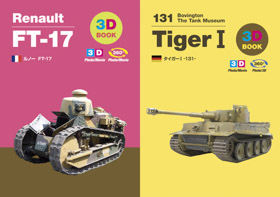
Publication of Renault FT-17 3D BOOK, a collection of stereo photographs by Nakamura Miki; in 2019, Tiger I -131- 3D BOOK.
2018 平成30
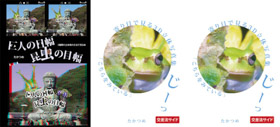
Takatsume's stereo photo collections Giant's Eyes, Insect's Eyes and Looking at You - 3D Stereoscopic Photography Collection were published.
- [JP]Giant's Eyes, Insect's Eyes | Amazon
- [JP]Looking at You - 3D Stereoscopic Photography Collection | Amazon
2019 令和1

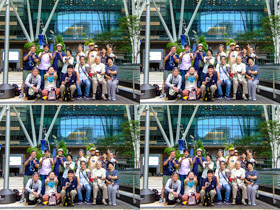
Celebrating the tenth anniversary of the FinePix Real3D
- [Photo] Group photo of participating members
2020 令和2
STEREO CLUB Tokyo the 1th Virtual Meeting and Exhibition
Sixteen virtual meetinqs under the pandemic were held until 16 October 2022.
- [参加作品リスト2020] #sct20200516 #sct20200606 #sct20200711 #sct20200829 #sct20201010 #sct20201114 #sct20201212
- [参加作品リスト2021] #sct20210213 #sct20210327 #sct20210501 #sct20211002 #sct20200516 #sct20211211
- [参加作品リスト2022] #sct20220219 #sct20200516 #sct20221015
2022 令和4

STEREO CLUB Tokyo Exhibition 2022 in Okegawa
2023 令和5

24th ISU World Congress 2023, JAPAN@Tsukuba
